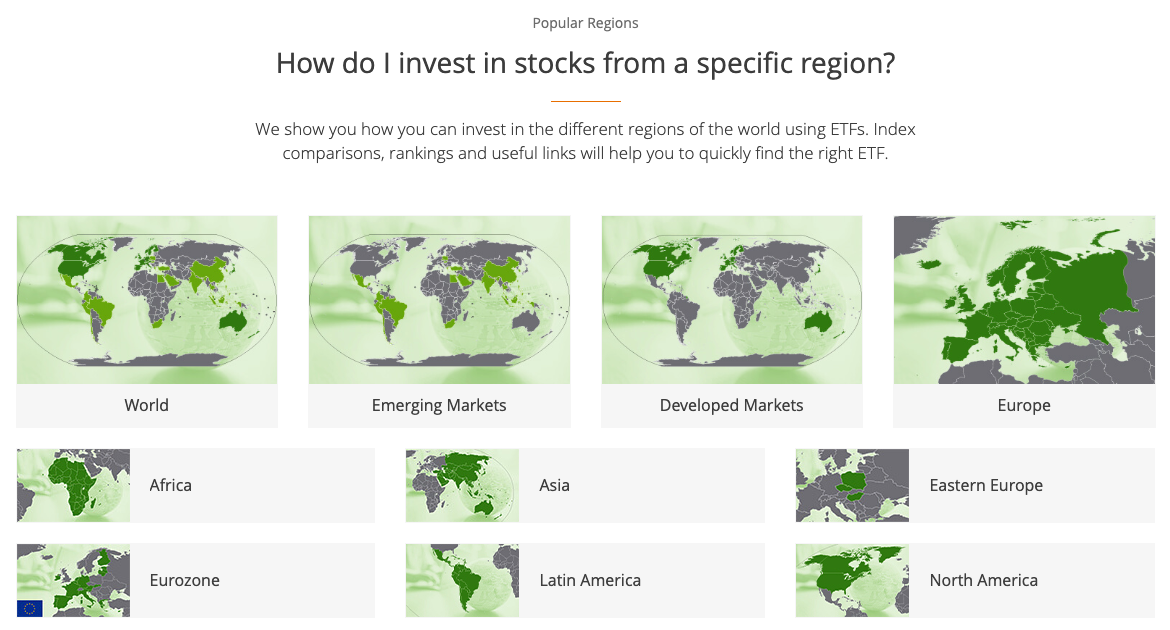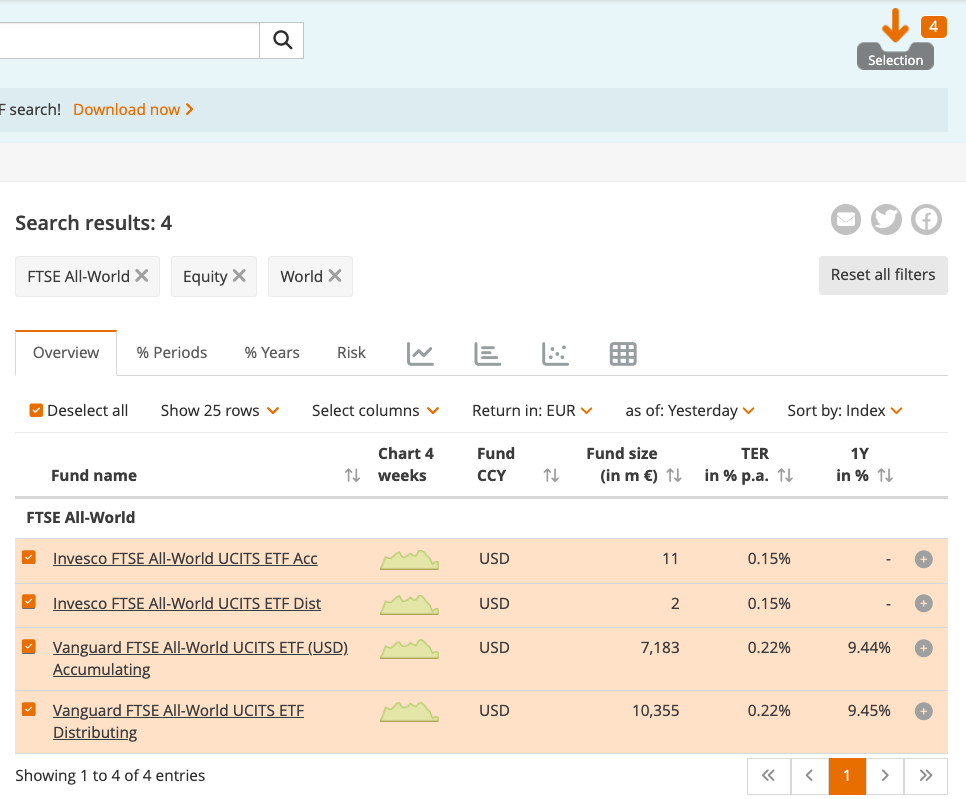
- Level: For beginners
- Reading duration: 10 minutes
What to expect in this article
Step 1: Find all global ETFs
The first step is to round-up every global ETF ready for shortlisting. Click through to our How to invest with ETFs guide to find the equity category you’re looking for. For global ETFs, click Regions at the top of the page, or scroll down to the section pictured below and click on the World region. You’ll now be on The Best World ETFs page which curates every global ETF in a single place.
There’s plenty of useful info here so it’s worth taking a few minutes to read up on the essentials.
We still need to refine our choice though. To do that, we can quickly compare every global ETF by scrolling down to the Indices on stocks from countries worldwide section.
Open each of the links you find in that section in a new tab. Or you can do it using the links below:
You’ll now be on The Best World ETFs page which curates every global ETF in a single place.
There’s plenty of useful info here so it’s worth taking a few minutes to read up on the essentials.
We still need to refine our choice though. To do that, we can quickly compare every global ETF by scrolling down to the Indices on stocks from countries worldwide section.
Open each of the links you find in that section in a new tab. Or you can do it using the links below:
Step 2: Grab your longlist of global ETFs
Each link populates a table with the ETFs that track each global index. We’ll use those tables to create our own masterlist for easy comparison. Click the Select all box under the Overview tab. You’ll see every ETF on page selected in orange like this: Repeat this process for each index link in step 2.
You’ve now got all 9 global ETFs in your Selection basket (see the icon in the top-right of the pic above).
Right-click on the Selection basket and choose Compare selection.
Repeat this process for each index link in step 2.
You’ve now got all 9 global ETFs in your Selection basket (see the icon in the top-right of the pic above).
Right-click on the Selection basket and choose Compare selection.
Step 3: Choose your selection criteria
You should now see every global ETF neatly arrayed in your own masterlist table as in the pic below. This Overview screen is brilliant for quickly whittling our longlist down to a shortlist. Prepare to cut ETFs that fail to meet your approval! The next step is to ensure you have a manageable set of key criteria on-screen. You’ll use these factors to decide which ETFs make the grade.
Dial up your key criteria using the Select columns function (It is above your result list).
The next step is to ensure you have a manageable set of key criteria on-screen. You’ll use these factors to decide which ETFs make the grade.
Dial up your key criteria using the Select columns function (It is above your result list).
- Click on the Select columns dropdown.
- Tick the criteria that matter to you – and deselect the rest – to keep your screen as clean as possible.

Why these criteria?
Some factors are vital, others are a personal choice. Here’s a quick guide to my selection:- Fund size: We just want to see the ETF has more than 100€ million in assets under management (AUM). ETFs that don’t scale to that size after a year or so may be closed down. That’s not catastrophic, but it's hassle you can do without.
- TER (Total Expense Ratio): TER refers to the annual expenses you’ll pay to the ETF provider to cover its management costs. Keeping your fees low is an important contributor to any investor’s long-term success as they’re deducted from your returns. Most ETFs are great value when compared to the traditional fund management industry, but it's worth periodically checking your product picks to ensure they remain competitive versus rival offerings.
- Distribution policy: Does the ETF pay out dividends into your account? This type of distributing fund is ideal for retirees who want income. Or does the product automatically reinvest the dividends for you? Accumulating ETFs are more convenient for non-retirees who are growing their wealth. Think of this distinction as a tie-breaker rather than mission-critical.
- 3Y in % and 5Y in %: These columns show 3-year and 5-year cumulative returns for each ETF. Longer track records are better as the figures can be buffeted by short-term noise. Don’t obsess about always choosing the fund with the best track record, though. ETFs are designed to follow their index, so we can expect competitive products to deliver similar results over time.
What we’re really looking for are any ETFs that seem off the pace. That may indicate the product is held back by high costs like a bloated TER or excessive transaction charges. It can also imply a lagging product that doesn’t replicate its index efficiently.
If an ETF is giving up more than 0.5% per year to its rivals over 5+ years then drop it from your list. - Inception date: New launches will often have competitive TERs but haven’t yet scaled nor established a proven track record. You may be tempted by the low fees but I prefer to wait a while until there’s at least three years worth of data to work from. That also gives the ETF time to gather enough assets under management to remain viable.
- Replication method: How does your ETF track its index? Full replication means your ETF physically holds every stock in the index. Optimised sampling is also a physical replication technique but the ETF screens out small and illiquid stocks which add to cost while making little difference to performance. A swap-based ETF doesn’t hold the index’s stocks at all. Instead it earns the index return using a financial derivative. This method is called synthetic replication and involves counterparty risk. Some investors prefer not to take counterparty risk.
- Securities lending: Some ETF providers earn extra revenue by lending out the fund’s securities to other financial operators who engage in short-selling. Strict guidelines apply to securities lending by UCITS ETFs and some of the profit is used to improve fund returns. That said, securities lending entails counterparty risk so you may prefer to avoid it.
justETF tip: I’ve dropped currency from my global ETF criteria because diversifying across currencies on the equity side of your portfolio is typically a positive move for most investors.
Step 4: Cut your longlist down to a shortlist
Now for the fun bit. Strike off any ETFs that don’t fulfil your key criteria: Just untick an ETF’s orange box to lose it from your list. Here’s the longlist: I will not give you my shortlist because I want you to make your own assumptions and decisions. But what I can tell you:
I will not give you my shortlist because I want you to make your own assumptions and decisions. But what I can tell you:
- Some ETFs were dropped because they’re so new.
- Some are double the cost of their competitors, so they’re out.
- I also dropped an accumulating ETF because it’s identical to its distributing twin except for its distribution policy and its later inception date. With that, I’ll be able to chart a much longer performance comparison between the remaining funds. The longer comparison will be based on the most recent inception date in the list (22.05.12) giving me an impressive 11-year timeframe to work with. This is a useful trick to employ when you want to compare products over periods longer than 5 years.
Step 5: Long-term test
To max out your shortlist’s performance timeframe, go to the Bar chart tab and hit the Max button. This can be a game-changer! I recommend testing it. The result for me: There’s actually very little between all of my three selected ETFs when the return differences are ironed out across 11 years. Certainly it’s not enough to worry about. The funds will probably continue to leapfrog each other at different times depending on temporary advantages rooted in their varying holdings.justETF tip: Go to the Risk Cloud tab to see annualised return and volatility data for each ETF. Click the ETF names under that chart to select / deselect their metrics.
Step 6: Decision time
Looking at the three ETFs on my short list, three things stands out:- The return of one ETF lagged a little on the 11-year view but it’s still close enough to the front two.
- All three ETFs use an optimised physical sampling replication method.
- I can buy accumulating versions of all three.
- It has the lowest TER of the three.
- It doesn’t use securities lending, so there’s no counterparty risk. I’m not particularly worried about that, but why take it if you don’t have to?
- Finally, justETF’s summary of the three rival indexes used by these ETFs tells me that this ETF has the most constituents and includes small cap stocks. (You can browse the index factsheets on this page too.)
















